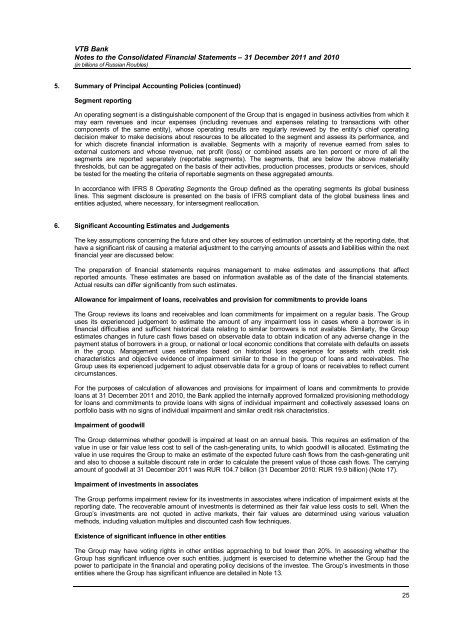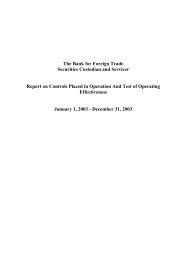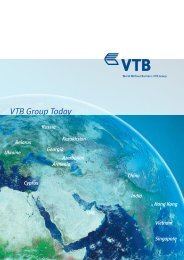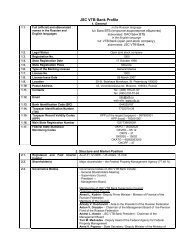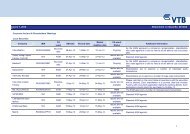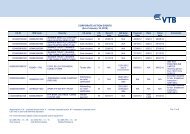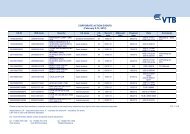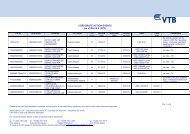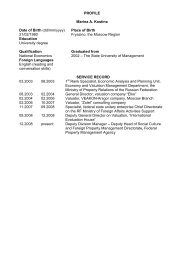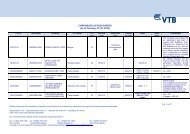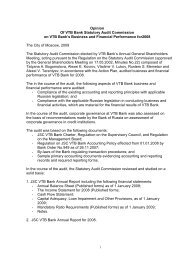Annual report 2011 - VTB
Annual report 2011 - VTB
Annual report 2011 - VTB
- No tags were found...
Create successful ePaper yourself
Turn your PDF publications into a flip-book with our unique Google optimized e-Paper software.
<strong>VTB</strong> BankNotes to the Consolidated Financial Statements – 31 December <strong>2011</strong> and 2010(in billions of Russian Roubles)5. Summary of Principal Accounting Policies (continued)Segment <strong>report</strong>ingAn operating segment is a distinguishable component of the Group that is engaged in business activities from which itmay earn revenues and incur expenses (including revenues and expenses relating to transactions with othercomponents of the same entity), whose operating results are regularly reviewed by the entity’s chief operatingdecision maker to make decisions about resources to be allocated to the segment and assess its performance, andfor which discrete financial information is available. Segments with a majority of revenue earned from sales toexternal customers and whose revenue, net profit (loss) or combined assets are ten percent or more of all thesegments are <strong>report</strong>ed separately (<strong>report</strong>able segments). The segments, that are below the above materialitythresholds, but can be aggregated on the basis of their activities, production processes, products or services, shouldbe tested for the meeting the criteria of <strong>report</strong>able segments on these aggregated amounts.In accordance with IFRS 8 Operating Segments the Group defined as the operating segments its global businesslines. This segment disclosure is presented on the basis of IFRS compliant data of the global business lines andentities adjusted, where necessary, for intersegment reallocation.6. Significant Accounting Estimates and JudgementsThe key assumptions concerning the future and other key sources of estimation uncertainty at the <strong>report</strong>ing date, thathave a significant risk of causing a material adjustment to the carrying amounts of assets and liabilities within the nextfinancial year are discussed below:The preparation of financial statements requires management to make estimates and assumptions that affect<strong>report</strong>ed amounts. These estimates are based on information available as of the date of the financial statements.Actual results can differ significantly from such estimates.Allowance for impairment of loans, receivables and provision for commitments to provide loansThe Group reviews its loans and receivables and loan commitments for impairment on a regular basis. The Groupuses its experienced judgement to estimate the amount of any impairment loss in cases where a borrower is infinancial difficulties and sufficient historical data relating to similar borrowers is not available. Similarly, the Groupestimates changes in future cash flows based on observable data to obtain indication of any adverse change in thepayment status of borrowers in a group, or national or local economic conditions that correlate with defaults on assetsin the group. Management uses estimates based on historical loss experience for assets with credit riskcharacteristics and objective evidence of impairment similar to those in the group of loans and receivables. TheGroup uses its experienced judgement to adjust observable data for a group of loans or receivables to reflect currentcircumstances.For the purposes of calculation of allowances and provisions for impairment of loans and commitments to provideloans at 31 December <strong>2011</strong> and 2010, the Bank applied the internally approved formalized provisioning methodologyfor loans and commitments to provide loans with signs of individual impairment and collectively assessed loans onportfolio basis with no signs of individual impairment and similar credit risk characteristics.Impairment of goodwillThe Group determines whether goodwill is impaired at least on an annual basis. This requires an estimation of thevalue in use or fair value less cost to sell of the cash-generating units, to which goodwill is allocated. Estimating thevalue in use requires the Group to make an estimate of the expected future cash flows from the cash-generating unitand also to choose a suitable discount rate in order to calculate the present value of those cash flows. The carryingamount of goodwill at 31 December <strong>2011</strong> was RUR 104.7 billion (31 December 2010: RUR 19.9 billion) (Note 17).Impairment of investments in associatesThe Group performs impairment review for its investments in associates where indication of impairment exists at the<strong>report</strong>ing date. The recoverable amount of investments is determined as their fair value less costs to sell. When theGroup’s investments are not quoted in active markets, their fair values are determined using various valuationmethods, including valuation multiples and discounted cash flow techniques.Existence of significant influence in other entitiesThe Group may have voting rights in other entities approaching to but lower than 20%. In assessing whether theGroup has significant influence over such entities, judgment is exercised to determine whether the Group had thepower to participate in the financial and operating policy decisions of the investee. The Group’s investments in thoseentities where the Group has significant influence are detailed in Note 13.25


